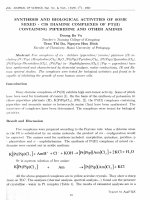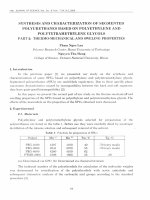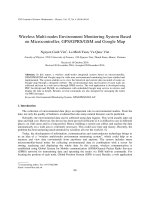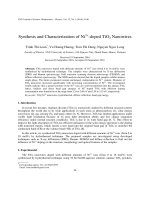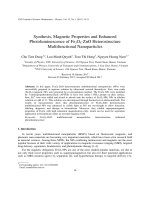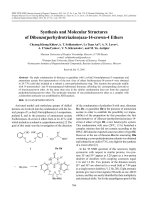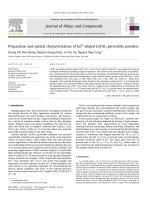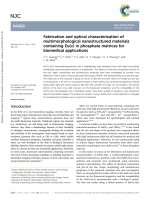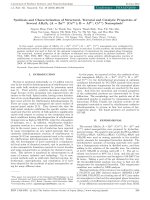DSpace at VNU: Synthesis and characterization of segmented Polyurethanes based on Polyethylene and Polytetramethylene glycols part 2: thermo-mechanical and sweling properties.
Bạn đang xem bản rút gọn của tài liệu. Xem và tải ngay bản đầy đủ của tài liệu tại đây (2.37 MB, 6 trang )
VNU. JOURNAL OF SCIENCE, Nat.. S cL & Tech., T .xx, N03, 2004
S Y N T H E S I S A N D CHARACTERIZATION OF S E G M E N T E D
P O L Y U R E T H A N E S B A S E D ON P O L Y E T H Y L E N E A N D
PO L Y T E T R A M E T H Y L E N E GLYCOLS
PART 2: THERMO-MECHANICAL AND SWELING PROPERTIES
Ph am N goc Lan
Polymer Research Cen ter, Hanoi University o f Technology
N gu yen Thu Hang
College o f Science, Vietnam N ational University, Hanoi
1. In trod u ction
In the previous paper [1] we presented our study on the synthesis and
characterization of some SPUs based on polyethylene and polytetramethylene glycols.
Segmented polyurethanes (SPUs) are multiblock copolymers. Due to their specific phase
separation characteristics caused by incompatibility between the hard and soft segments,
they have quite good biocompatibility [2].
In this paper we present the second part of our study on the thermo-mechanicahand
swelling properties of the SPUs based on polyethylene and polytetram ethylene glycols. The
effects of the macrodiols on the properties of the SPUs obtained were discussed.
2. E xp erim en tal
2.1. M a teria ls
Polyethylene
and
polyteramethylene
glycols
selected
for
preparation
of the
polyurethanes are listed in the table 1. Before use they were carefully dried by azeotropic
distillation of the toluene solution and subsequent removal of the solvent.
Table 1: Polydiols for preparation of SPUs
Polyol
M n“
Mn
Tm,°c
Tg, °c
PEG -1000
PEG-2000
PEG-4000
PTMO-2000
1207
2341
4280
2186
1100
2070
4109
1950
40
55
62
25
-70 (very weak)
-70 (very weak)
-
-30
(a): Determined via GPC; (b): Determined via chemical titration
The hydroxyl num ber of the polyetherdiols for calculation of the molecular weights
was determined bv esterification of the polyetherdiols with acetic anhydride and
subsequent titrim etric analysis of the carboxylic acid groups according to the standard
procedure [3].
19
Pham N u o c Lan, N m iy cn T ill! Hang
The molecular weights of the polydiols were also verified by m eans of gel permeation
chromatography (PL columns, 103A°, 7mm i. d., 60 cm length, Polymer Laboratories Ltd,
Shropshire, UK. Eluent: chloroform, Differential reflectometric detection (Model Waters
4 0 1 , Millipore, MA, USA). Data analysis occurred on a w aters d ata module model M730.
Calibration was based on a peak position calibration curve established using polystyrene
standards (Millipore, Millford, MA, USA).
Diisocyanate (MDCI) (Aldrich Bornem, Belgium) was vacuum distilled and stored
under dried conditions in a refrigerator prior to use.
1,4-butane diol (Aldrich, Bornem, Belgium) was dried over calcium hydride for 2
days, distilled and stored under nitrogen.
Dibutyl tin diacetate was obtained from Aldrich (Bornem, Belgium) and used without
further purification.
Dimethyl formamide (DMF) (Aldrich Bornem, Belgium) was dried over calcium
hydride for 2 days and then vacuum distilled.
2.2. Characterization methods
DSC thermograms were recorded on a P erkin-E lm er DSC u n d er nitrogen purging
(seating rate 10°c.min \ from -100°c to 100°C). The u n it was equipped with a data
processing module that allows substraction of the background an d normalization for sample
veight.
Uniaxial stress-strain experiments were carried out on a Hounsfield Test Equipment
ỊÍ10-KM at 25° c (film samples 20mm in length, 5mm wide, thickness: 0.12 - 0.15 mm,
crosshead: 5mm.min l). The swelling test was carried out in distilled w ater and phosphate
buffer solution (pH = 7.4) at different tem peratures.
2.3. Polymer pr ep ar ation
The SPUs preparation was made according to the procedure described in the previous
paper [1]. Briefly, the reaction for making the SPUs was carried out by two-stage
procedure. In the first stage, the macrodiol (MD) in DMF reacts with diisocyanate (DI) with
tie molar ratio MD/DI : 1/2, at 90°c for 2 hours. Dibutyl tin diacetate was used as catalyst.
rjhe reaction mixture was then cooled down to the room tem p eratu re. Afterward 1,4-butane
(iol as a chain extender was added and the chain extension reaction was carried out at
<0°c for 2 hours. The end copolymer product was precipitated in water. After drying it was
^dissolved in THF and reprecipitated in the solvent m ixture hexane-ether (1/1). The
copolymer product was dried under vacuum a t 60°c a t least for 2 days.
V N U . Jo u rn al o f Science, N a t.. Sci.. & Tech.. I XX, N J . 2004
Synthesis and ch aracterizatio n o f
3. R esults and d is c u s s io n
3.1. NMR spectra a n d IR analysis
The stru ctu re of the SPUs obtained was confirmed by proton NMR and IR spectra.
The NMR and IR absorption bands of the SPUs were shown in the previous paper [1].
3.2. DSC analysis o f SPUs
The soft segm ent glass transition tem p eratu re (Tg) and the melting tem p eratu re
(Tin) of the SPUs obtained from the DSC d ata are summarized in the table 2.
Table 2: DSC data of SPUs
Polyol ratio
P E G -1000 + PTMO-2000
PEG-2000 + PTMO-2000
PEG-4000 + PTMO-2000
PEG-2000 + PTMO-2000
PEG-2000 + PTMO-2000
PEG-2000 + PTMO-2000
Code
PƯ-1
PƯ-2
PU-3
PU-4
PƯ-2
PU-Õ
Tg, °c
(1/1)
(1/1)
(1/1)
(1/2)
(1/1)
(2/1)
-
-55
-60
-60
-55
-60
Tm, "C
-121.5
35.5 / 20
4 8 / 18
34/18
35.5 / 20
4 0 /2 7
The polymers show the melting tem p eratu re (Tm) which increases with increasing
the molecular weight of the polyethylene glycols. Possibly, this is due to an increase in the
size of the soft segm ent crystallinity. The increasing of the crystalline domain probably
restricts the solubilization of the h ard segm ents into the soft segments and consequently
makes the system more incompatible. This implies th a t the material becomes more phafce
separated. Following from PU-4 to PU-2 and to PU-5 we can see th a t the Tm increases with
increasing the PEG-2000/PTMO-2000 ratio. The increase in ratio between PEG-2000 and
PTMO-2000 means the increase in crystalline domain. This causes again the enhancement
of the phase separation. This resu lt is in agreem ent with th a t of other authors [2,4,5].
3.3. Tensile pr operti es
The tensile properties of the SPUs are shown in the table 3.
Table 3: Tensile properties of the SPUs
Code
PU-1
PU-2
PU-3
PU-4
PU-2
PU-5
Polydiol ratio
PEG -1000
PEG-2000
PEG-4000
PEG-2000
PEG-2000
PEG-2000
+
+
+
+
+
+
PTMO-2000
PTMO-2000
PTMO-2000
PTMO-2000
PTMO-2000
PTMO-2000
(1/1)
(1/1)
(1/1)
(1/2)
(1/1)
(2/1)
V N U . Journal o f Science. N a t.. Sci.. & Tech., T XX, N lt3. 2004
Tensile
at break,
MPa
7.0
12.1
15.2
9.0
12.1
13.8
Ultimate
Tensile,
MPa
8.5
12.6
15.7
10.6
12.3
14.0
Elongation
at break,
%
650.0
570.2
480.0
600.4
555.2
490.0
Pham N eoc Lan, N mi ven Thu Han Li
When comparing PU-1 with PU-2 and PU-3 we can see the increase in tensile
strength upon increasing the molecular weights of the polyethylene glycols. DSC data have
shown th at the phase separation was increasing from PU-1 to PƯ-3. On the other hand, the
crystalline domain of the soft segments in the SPUs is increasing from PU-1 to PU-3 too.
Thus, larger crystalline domain in the soft segments could be the cause for the better
tensile properties of the resulted SPUs. The same law can be observed when comparing PU4 with PU-2 and PƯ-5. An increase in ratio of PEG-2000 to PTMO-2000 means the increase
in crystalline domain of the soft segments and would be the reason for improving the
tensile strength of the SPUs.
3.4. Swelling study
The swelling study was carried out in distilled water at different tem pertures, the
results are shown in figure 1:
For the all SPUs samples, the swelling decreases with rising tem peratures. When
comparing PU-1 with PU-2 we see the swelling of PU-2 is much higher th an th a t of PU-1.
This is due to lareger crystalline domain of the soft segments in PƯ-2 compared to th at in
PU-1.
If we compare PU-4 with PU-2 and PU-5, we can see also the increase in swelling
from PU-4 to PU-2 and to PU-5. Here again, the reason would be the same: the increase in
swelling is due to enhancem ent of the crystallinities from PU-4 to PU-2 and to PU-5.
Figure 1: The swelling curves of the SPƯS in water at different temperatures
V N U . Journal o f Science. N a t., Sci..
ổi Tech..
ỉ '.XX. N J . 2004
23
Synthesis and charactcrization of.
The same swelling behaviour of the SPUs in buffer solution can be observed in Figure 2.
Comparing PU l with PU2 and PƯ3 we can see th a t when molecaular weight of the
soft segments of SPUs is increasing from P U l to PU2 and PU3, the swelling is also
increasing from P U l to PU2 and PU3. The swelling is increasing from PU4 to PU2 and PU5
when the ratio PEO-2000: PTMO 2000 in the soft segments is increasing. It can be
therefore concluded th a t the swelling behavior of the selected SPUs for study is strongly
dependent on the PEO am ount and PEO molecular weight.
700
600
500
Ị
-B—PU-1
-*•—PU-2
400
■*” PU-3
1 300
cn
200
-*-P U -4
PU-5
100
0
5
10
15
20
25
30 37.5
Temperature, °c
4. C onclusion
The data obtained show th a t the increase in PEO am ount as well in PEO molecular
weight of the macroether diols in the SPUs soft segments results in enhancem ent of their
crystalline domain making the SPUs more phase separated. The mechanical and swelling
properties of the SPUs are increasing upon increasing the crystalline domain of the soft
segments in the SPUs as well.
REFERENCE
1.
Pham Ngoe Lan, Schacht E., J. o f Science, Natural Sciences and Technology, T. 19, No 6
(2003), 21-28.
2.
P.N. Lân, Corneillie s., Schacht E., Davies M. and Shard A., Biomaterials, 17 (1996), 22732280.
3.
Sorenson WR., Campbell TW., Preparative Methods o f Polymer Chemistry. New York:
Interscience, (1961).
V N U . Journal o f Science. N a t.. Sci.. á Tech.. T. XX. A y . 2004
Pham N ỉioc Lan, N g u yen T h u Hang
24
4.
Li I., Ren z., Zhao M., Yang H., Chu B. Multiphase structure of segmented polyurethanes:
Effect of hard segment flexibility, Macromolecules, 26, (1993), 612-622.
5.
Aitken R. R., Jeffs G. M. F., Thermoplastic Polyurethane elastomers based on aliphatic
diisocyanates: Thermal Transitions, Polymer, 18, (1977) 197-198.
TẠP CHÍ KHOA HỌC ĐHQGHN, KHTN & CN, T.xx, SÒ 3, 2004
TỔNG HỢP v à k h ả o s á t t í n h c h a t c ủ a c á c p o l y u r e t a n p h â n
ĐOẠN (PU) TRÊN c ơ s ở POLYETYLEN GLYCOL VÀ
POLYTETRAMETYLEN GLYCOL
(PHẦN II: NGHIÊN c ứ u TÍNH CHAT c ơ LÝ VÀ ĐỘ TRƯƠNG)
Phạm N gọc Lân
Trung tăm N ghiên cứu Vật liệu Plyme, Đại học Bách khoa Hà Nội
N g u y ễn Thu Hằng
Trường Đại học Khoa học Tự nhiên, ĐHQGHN
Trong bài báo trước (1) đã nghiên cứu phương pháp tổng hợp, đặc trưng cấu trúc và
hình thái học của một sô polyuretan (PU) trên cơ sở polyetylen glycol và polytetrametylen
glycol. Bài báo này đê cập vê nghiên cứu tính chất cơ lý và độ trương cúa các loại PU trên
trong nước và dung dịch đệm. Đã thảo luận về ảnh hưởng của th àn h phần và cấu trúc của
monome ban đầu lên tính chất cơ lý và độ trương của PU sản phẩm.
Từ khóa: Polyuretan p h â n đoạn, tách p h a , tính chất cơ lý, độ trương.
V N U . Journal o f Science, N at., S ri.. & Tech., T. XX. N J . 2004

